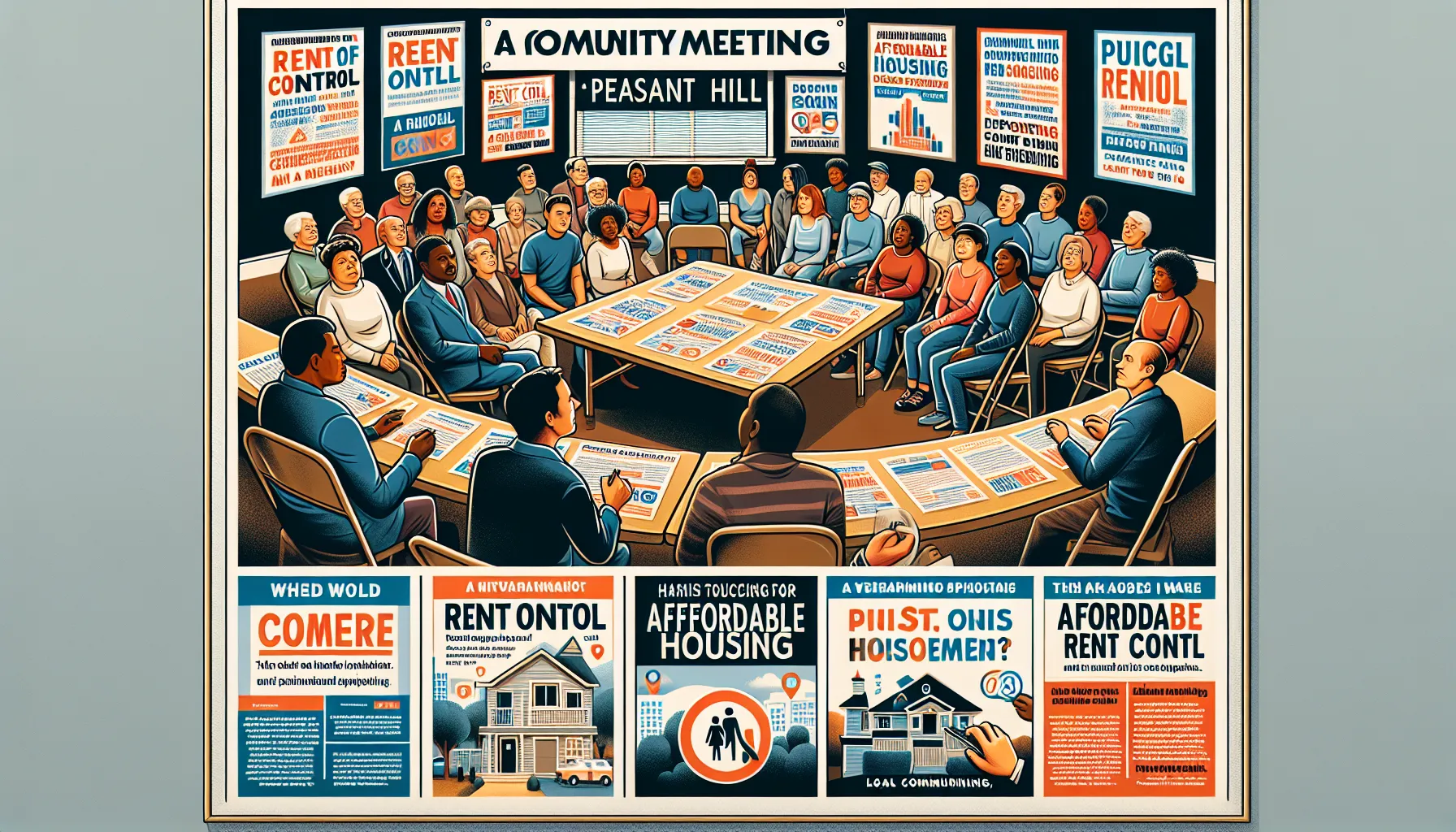Key Takeaways
- Rent control in Pleasant Hill primarily aligns with California’s Assembly Bill 1482, capping annual rent increases for most older multifamily units at 5% plus local CPI (up to 10%).
- Most single-family homes, condos, and newer properties are exempt from local rent control regulations, focusing protections on long-term tenants in older rental buildings.
- Rent control provides tenants with greater housing stability and predictability, while landlords benefit from reduced disputes but may face challenges covering rising maintenance or repair costs.
- Community opinions are mixed, with renters prioritizing affordability and security, and property owners expressing concerns about investment incentives and property upkeep.
- Compared to neighboring cities, Pleasant Hill’s rent control framework is moderate, offering fewer local restrictions than Berkeley or Oakland but similar to Concord and Walnut Creek.
- Ongoing policy updates and market trends may further shape rent control in Pleasant Hill, making it important for both landlords and tenants to stay informed about regulatory changes.
Rent control is a topic that sparks plenty of discussion, especially in places like Pleasant Hill where housing demand keeps rising. Many people wonder how these regulations affect both renters hoping for stable costs and property owners looking to protect their investments. I know how confusing it can feel to sort through the details and figure out what’s really at stake.
Are you curious about how rent control shapes the local market or what it means for your own plans? You’re not alone. Whether you’re a homeowner, investor, or tenant, understanding how these rules work can help you make more informed decisions. Let’s take a closer look at the factors that matter most and explore how rent control impacts Pleasant Hill’s housing landscape.
Understanding Rent Control in Pleasant Hill
Rent control in Pleasant Hill sets guidelines for how much landlords can increase rent each year. These regulations help keep housing costs stable for long-term tenants. For property owners, knowing these limits lets them plan for returns while protecting their investment.
The city’s rent control measures often reflect trends seen across California. Restrictions typically apply to older multifamily buildings, while newly constructed properties or single-family homes may be exempt. Have you noticed how rent policies often change depending on the age or size of your property?
For tenants, these rules often provide reassurance that rent hikes won’t disrupt their financial plans. Many renters rely on these protections to maintain stable living situations. Owners also benefit, since clear rent guidelines can reduce disputes and foster positive tenant relationships. How do you think rent control shapes trust between owners and residents in Pleasant Hill?
Rent control rules in this market influence both supply and demand. Landlords might feel the impact when setting rates for new leases, especially if maintenance costs rise. Knowing these limits can also affect decisions about upgrading properties or shifting investment strategies.
Regulation details sometimes shift, and compliance helps both parties avoid issues. Consistent communication and regular updates about rules give everyone peace of mind. Do you find staying informed about housing policies helps you manage or select rentals with greater confidence?
Understanding Pleasant Hill’s rent control framework means you can make smarter choices—whether you’re leasing a unit, managing multiple properties, or searching for a rental.
Historical Context of Rent Control Policies

Rent control policies first appeared in the United States during the 1940s, responding to housing shortages after World War II. Local governments then used these rules to keep housing affordable and prevent sudden rent hikes during times when demand greatly outpaced supply. Have you wondered why these policies come back into debate each time housing markets tighten?
California’s rent control history shows how public needs often shape local laws. In the late 1970s, several cities such as Berkeley and San Francisco started passing rent control ordinances. These laws generally covered older multifamily units, setting limits on annual rent increases and requiring landlords to show cause before evicting tenants. Policies changed in response to shifting economic pressures, with amendments reflecting the balance between tenant protections and owners’ property rights.
Statewide, the Costa-Hawkins Rental Housing Act of 1995 became a turning point. This legislation limited the scope of local rent control by exempting single-family homes and most buildings constructed after February 1, 1995. In Pleasant Hill, as in other California communities, such state laws set the framework within which local governments could draft their own rent regulations. Some residents might ask: How have these statewide rules affected decisions made at the city level?
Recent changes brought about by Assembly Bill 1482, effective since 2020, introduced rent caps and added “just cause” eviction protections across most of California, including Pleasant Hill. This law created a more consistent standard that many renters and owners felt provided greater predictability. Given these shifts, how have you seen your housing situation affected, or what adjustments have you noticed in your community?
Understanding this history highlights why rent control remains an ongoing topic. Policies from decades past continue to influence how Pleasant Hill and nearby areas shape rental laws today.
Current Rent Control Regulations in Pleasant Hill

Understanding rent control in Pleasant Hill often feels overwhelming, especially with rules that affect both renters and property owners. Are you curious about how these local measures might impact your lease or investment? I’ll break down the essentials in straightforward language.
Key Provisions and Enforcement
Current rent control measures in Pleasant Hill largely align with California’s statewide standards. Most notably, Assembly Bill 1482—enacted statewide in 2020—limits annual rent increases for eligible properties to 5% plus the local Consumer Price Index, with a total cap of 10% per year. This cap applies to most multi-unit buildings built before 2005. However, single-family homes and condominiums, if owned by individuals rather than corporations, often remain exempt. Newly built residential properties, generally constructed within the past 15 years, are also outside these regulations.
Enforcement focuses on compliance from both landlords and tenants. Local authorities monitor adherence, investigating complaints of unlawful rent hikes or improper eviction attempts. If property owners don’t follow the rules, they may face financial penalties or orders to restore tenants’ former rental rates. Renters, for their part, receive formal notice of any increases as required by law. Have you checked lately if your building falls under these rules, or if your recent rent increase followed the proper procedure?
Recent Changes and Updates
Recent changes stem from California’s Assembly Bill 1482, which shaped most of Pleasant Hill’s rent control landscape beginning in January 2020. This law standardized rent caps and “just cause” eviction protections, setting clear guidelines for most rental agreements. For example, eviction now requires specific reasons such as nonpayment, lease violations, or major property renovations, giving renters more stability. Local updates occasionally add further detail or adjust how certain exemptions work, particularly for properties transitioning between ownership or changing use.
State law updates or local clarifications sometimes create new questions for renters and owners. Have you reviewed your lease or property portfolio to see if any new rules apply to your situation? Keeping up-to-date can make managing your next lease or property decision much simpler.
Economic Impact of Rent Control in Pleasant Hill

Rent control plays a major role in shaping Pleasant Hill’s rental market dynamics. If you’ve ever wondered how these laws affect both property values and rental costs, this analysis covers the direct outcomes for residents and investors in the area.
Effects on Housing Supply and Affordability
Rent control influences Pleasant Hill’s available housing supply, especially for multi-unit buildings built before 2005. By capping rent increases at 5% plus the local Consumer Price Index (but not exceeding 10% per year as set by AB 1482), owners might have fewer incentives to invest in upgrades or add new units. This cap can steady costs for current tenants, making it easier for long-term residents to stay in their homes.
If you’re searching for a rental, you might notice that price increases are moderate year over year for older apartments, compared to markets without these limitations. However, some property owners hold back on significant property improvements or converting single-family homes into rentals, since returns can be lower over time. Have you or your neighbors felt a shift in available listings or quality upgrades due to rent control rules?
Impact on Landlords and Tenants
For landlords, rent control creates stability but limits flexibility. Regular, moderate rent increases can provide reliable income streams, yet owners may find it challenging to cover sudden cost spikes such as major repairs or insurance premiums. This balance particularly affects those managing smaller portfolios—many handle only five to ten units—where unexpected expenses have a bigger impact on profit margins.
For tenants, these laws provide security and predictability. Knowing that your rent won’t jump unpredictably each year removes a major source of stress and helps with budgeting for families and individuals alike. Residents gain peace of mind, staying in place longer and building stronger community ties as a result.
Have you, as a landlord or tenant, noticed how steady rent makes planning for the future easier? Are you seeing any benefits, or perhaps new challenges, under these guidelines? Many in Pleasant Hill find these policies offer reassurance, but sometimes raise questions about long-term housing upgrades and supply.
Community Perspectives on Rent Control

People in Pleasant Hill talk often about rent control. Residents weigh in with personal stories and ideas about its effects on their living situation or property investment. What concerns affect your perspective the most?
Support and Opposition From Residents
Many renters welcome rent control rules. They say limits on annual increases help them stay in their homes without fearing sudden price hikes. These tenants report feeling less financial stress and more connected to their neighborhoods. For example, several locals shared they could budget better and plan for the future due to rent caps.
Some homeowners and other residents express reservations. They worry rent restrictions could lead landlords to cut back on maintenance or avoid renting units altogether. A few point to properties in need of repairs as evidence. The question remains: In your experience, have rent caps improved your housing situation, or created new challenges?
Stakeholder Opinions: Property Owners and Advocacy Groups
Property owners often share detailed feedback. Landlords say rent limits make it harder to keep up with expenses or plan property upgrades. These owners mention challenges with rising maintenance and tax costs compared to capped rental income, especially in older buildings.
Advocacy groups focus on tenant stability and affordable housing access. Many urge further protections, hoping to keep Pleasant Hill inclusive. They highlight stories of neighbors gaining peace of mind and staying rooted in the area. Both sides sometimes join community meetings to share these points of view. How do you feel these regulations influence your plans for renting, owning, or investing in Pleasant Hill?
Comparative Analysis With Neighboring Cities

Rent control policies in Pleasant Hill often look similar to rules in nearby cities. For example, Concord and Walnut Creek have rental guidelines based on California Assembly Bill 1482, capping annual rent increases at 5% plus the local Consumer Price Index, never exceeding 10%. Lafayette and Martinez also adopt statewide rent caps, with single-family homes and newer properties exempt in many cases.
Looking at cities like Oakland and Berkeley, I notice stronger controls. Both cities add additional local rent boards, registration requirements, and stricter just-cause eviction rules. Owners there face more detailed compliance steps. That level of oversight gives tenants significant stability but may make owners feel restricted.
Pleasanton, San Ramon, and Livermore typically apply only the statewide rules with no extra local ordinances. Properties here often have more flexibility for rent adjustments and fewer administrative hurdles.
Here’s a comparison of key rent control features in the area for context:
| City | Annual Rent Increase Cap | Local Rent Board | Additional Eviction Protections | Property Exemptions |
|---|---|---|---|---|
| Pleasant Hill | 5% + CPI (max 10%) | No | Statewide (AB 1482) | SFHs, condos, new builds |
| Concord | 5% + CPI (max 10%) | No | Statewide (AB 1482) | SFHs, condos, new builds |
| Walnut Creek | 5% + CPI (max 10%) | No | Statewide (AB 1482) | SFHs, condos, new builds |
| Oakland | CPI (varies, 3–7%) | Yes | Stricter local rules | New build/owner-occupied |
| Berkeley | CPI (varies, 1–3%) | Yes | Stricter local rules | New build/owner-occupied |
| Pleasanton | 5% + CPI (max 10%) | No | Statewide (AB 1482) | SFHs, condos, new builds |
What stands out to you about these differences? Does a simpler framework appeal to you, or would you value the added tenant protections found in cities like Berkeley? Comparing local policies might help you decide if Pleasant Hill’s approach matches your needs, whether you own rental property or rent your home. How do you see these rules influencing your choices or sense of stability?
Future Outlook for Rent Control in Pleasant Hill

Change shapes the outlook for rent control in Pleasant Hill. Housing laws in California adjust with state and local trends, and Pleasant Hill may soon see updates driven by shifts in demand, rising costs, and new state mandates. Legislators in Sacramento recently adjusted rent increase caps and expanded eviction protections through Assembly Bill 1482, showing that future changes often reflect broader market tensions and voter concerns.
Growth in renter demand, combined with pressures on housing supply, signals ongoing attention from policymakers. Pleasant Hill’s current rent control aligns with statewide caps—5% plus inflation, up to 10% annually for qualifying properties. If inflation rises or more properties convert to rentals, could new policies tighten or expand these controls further? Historically, cities have added stricter local rules after high-profile tenant advocacy campaigns or regional market instability.
Advocacy groups in Pleasant Hill routinely lobby for enhanced tenant protections, such as stricter limits on rent increases or new funding for affordable housing projects. Owners and investors watch these efforts closely, aware that restrictions may shift investment returns or shape renovation plans. Some landlords express concern over the impact of restricted flexibility, particularly if expenses like insurance and maintenance outpace allowed rent hikes.
Market factors also make a difference. Major employers relocating to Pleasant Hill or the East Bay could drive up rental demand, putting added focus on access and affordability. This might prompt community conversations about whether the current rent control framework fits renters’ needs and property owners’ financial realities. Have you noticed a change in local rents or heard neighbors raising concerns about affordability?
Technological tools and data collection now help property owners and tenants monitor changes to rent laws more easily. Keeping up with updates prevents surprises and helps all parties plan ahead. What resources have made it easier for you to follow new regulations or advocate for your interests?
Statewide, housing remains a priority. California legislators continue to propose housing-related bills each session, with frequent reviews of how policies meet the needs of cities like Pleasant Hill. Watching these developments—and talking regularly with fellow renters or owners—helps everyone stay informed.
Questions remain about the best way to balance stable rent with incentives for new construction and property improvements. How do you see Pleasant Hill’s needs changing in the next few years? Sharing your experiences may help shape future decisions, as city leaders often listen to local voices during policy reviews.
Conclusion
Rent control in Pleasant Hill is always evolving and it’s clear that staying informed is essential. Whether I’m a renter looking for stability or a property owner navigating regulations I know that understanding the local landscape gives me an edge.
The choices I make now—about where to live invest or manage property—depend on how well I grasp these rules. By keeping up with changes and connecting with others in the community I can help shape a fair and balanced rental market for everyone.
Frequently Asked Questions
What is rent control in Pleasant Hill?
Rent control in Pleasant Hill refers to regulations that limit the amount landlords can increase rent each year, primarily for older multi-unit properties. The rules mostly follow California’s statewide standards, helping tenants manage housing costs and providing property owners with guidelines for setting rent.
Which properties are subject to rent control in Pleasant Hill?
Most multi-unit buildings built before 2005 are covered by rent control. Single-family homes, condominiums owned by individuals, and newly constructed buildings are generally exempt from these regulations.
How much can landlords increase rent under current laws?
Under Assembly Bill 1482, annual rent increases are limited to 5% plus the local Consumer Price Index (CPI), with a maximum cap of 10% per year for most covered properties in Pleasant Hill.
Are there eviction protections for tenants?
Yes, Assembly Bill 1482 provides “just cause” eviction protections for many tenants. This means landlords must have a valid reason, such as nonpayment or lease violations, to evict renters in covered properties.
How does rent control benefit tenants?
Rent control offers tenants increased stability by restricting rent hikes, making it easier for renters to budget and stay in their homes long-term without sudden, disruptive increases.
What challenges do landlords face with rent control?
Landlords face limits on rent adjustments, which can make it harder to cover unexpected expenses or fund property upgrades. However, the regulations also create predictable income streams and help plan long-term investments.
How is rent control enforced in Pleasant Hill?
Local authorities monitor compliance with rent control laws. Penalties may be imposed on landlords or tenants who violate the rules, ensuring both sides follow established guidelines.
How does Pleasant Hill’s rent control compare to nearby cities?
Pleasant Hill, along with most cities in Contra Costa County, follows California’s statewide rent control rules. Neighboring cities like Oakland and Berkeley have stricter local regulations, while others stick to state law.
Will rent control laws in Pleasant Hill likely change in the future?
Housing laws are frequently reviewed and can change based on market trends, advocacy efforts, and economic shifts. Staying informed about new legislation is important for both renters and property owners.
What should tenants and landlords do to stay compliant?
Both parties should read their lease agreements carefully, stay updated on state and local laws, and communicate about regulation changes. Consulting local housing authorities ensures everyone understands their rights and obligations.
